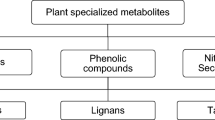Abstract
Hydroperoxide lyase activity was found in sugar beet leaves. Its optimum pH and temperature were, respectively, 6.7 and 22°C. Under these conditions, conversion of linolenic acid 13-hydroperoxide to cis-3-hexenal with a maximum yield of 80% was reached after only 2 min. The stability of cis-3-hexenal was improved by acidifying the reaction medium. Based on these studies, a bioprocess producing green-note aldehydes in a laboratory-scale was achieved.



Similar content being viewed by others
References
Baysal T, Dermirdöven A (2007) Lipoxygenase in fruits and vegetables: A review. Enzyme Microb Technol 40:491–496
Fauconnier M-L, Marlier M (1996) An efficient procedure for the production of fatty acid hydroperoxides from hydrolyzed flax seed oil and soybean lipoxygenase. Biotechnol Tech 10:839–844
Fauconnier M-L, Perez AG, Sanz C et al. (1997) Purification and characterization of tomato leaf (Lycopersicon esculentum Mill.) hydroperoxide lyase. J Agric Food Chem 45:4232–4236
Fukushige H, Hildebrand DF (2005) A simple and efficient system for green note compound biogenesis by use of certain lipoxygenase and hydroperoxide lyase sources. J Agric Food Chem 53:6877–6882
Hatanaka A (1993) The biogeneration of green odour by green leaves. Phytochem 34:1201–1218
Kishimoto K, Matsui K, Ozawa R et al. (2006) Components of C6-aldehyde-induced resistance in Arabidopsis thaliana against a necrotrophic fungal pathogen, Botrytis cinerea. Plant Sci 170:715–723
Marczy JSz, Németh ASz, Samu Z et al. (2002) Production of hexanal from hydrolyzed sunflower oil by lipoxygenase and hydroperoxide lyase enzymes. Biotechnol Lett 24:1673–1675
Matsui K (2006) Green leaf volatiles: hydroperoxide lyase pathway of oxylipin metabolism. Curr Opin Plant Biol 9:274–280
Németh ASz, Marczy JSz, Samu Z et al. (2004) Biocatalytic production of 2-(E)-hexenal from hydrolysed linseed oil. Enzyme Microb Technol 34:667–672
Noordermeer MA, Van der Goot W, Van Kooij AJ et al. (2002) Development of a biocatalytic process for the production of C6-aldehydes from vegetable oils by soybean lipoxygenase and recombinant hydroperoxide lyase. J Agric Food Chem 50:4270–4274
Schade F, Thompson JE, Legge R (2003) Use of a plant-derived enzyme template for the production of the green-note volatile hexanal. Biotechnol and Bioeng 84:265–273
Vancanneyt G, Sanz C, Farmaki T et al. (2001) Hydroperoxide lyase depletion in transgenic potato plants leads to an increase in aphid performance. Plant Biol 98:8139–8144
Whitehead IM, Slusarenko AJ, Waspi U et al. (2001). Guava (Psidium Guajava) 13-hydroperoxide lyase and uses thereof. US Patent 6,200,794 B1, 13 mar 2001
Acknowledgement
This work is financed by the Agricultural General Direction—Walloon Region of Belgium. Ongena M is research associate at the FRS-FNRS in Belgium. Gigot C is recipient of a FRIA grant from the FRS-FNRS.
Author information
Authors and Affiliations
Corresponding author
Additional information
The authors Holy N. Rabetafika and Cédric Gigot contributed equally.
Rights and permissions
About this article
Cite this article
Rabetafika, H.N., Gigot, C., Fauconnier, ML. et al. Sugar beet leaves as new source of hydroperoxide lyase in a bioprocess producing green-note aldehydes. Biotechnol Lett 30, 1115–1119 (2008). https://doi.org/10.1007/s10529-008-9652-2
Received:
Accepted:
Published:
Issue Date:
DOI: https://doi.org/10.1007/s10529-008-9652-2




